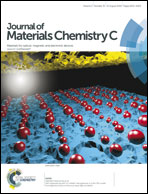Os(ii) metal phosphors bearing tridentate 2,6-di(pyrazol-3-yl)pyridine chelate: synthetic design, characterization and application in OLED fabrication†
Abstract
Treatment of 2,6-di(5-trifluoromethylpyrazol-3-yl)pyridine (pz2py)H2 with Os3(CO)12 affords a mononuclear Os(II) complex [Os(pz2py)(CO)2(H2O)] (1) in excellent yield. Ligand substitution reactions were next executed to identify products with good photoluminescence at both fluid and solid states at RT. Therefore, substitutions with phosphorus donors such as PPh2Me and 2,6-bis(diphenylphosphinomethyl) pyridine (P2N), and nitrogen donors such as pyridine, 2,2′-bipyridine (bpy) and 2,2′:6′,2′′-terpyridine (tpy), afforded products with formula [Os(pz2py)(PPh2Me)2(CO)] (2), [Os(pz2py)(P2N)] (3), [Os(pz2py)(CO)2(py)] (4), [Os(pz2py)(CO)(bpy)] (5) and [Os(pz2py)(CO)(tpy)] (6). The single crystal X-ray structural analyses were executed on 1, 2, 3 and 6 to reveal the bonding of pz2py chelate as well as the structural effect imposed by the phosphorus and/or nitrogen donor groups. The photophysical properties were studied and discussed using the results of DFT and TDDFT calculations. For application, fabrication and analysis of organic light emitting diodes (OLEDs) were also carried out. OLEDs using 2 as a dopant exhibited an intense yellow emission with a maximum efficiency of 18.3%, 61.0 cd A−1, and 53.8 lm W−1, which are higher than those of most reported devices with greenish yellow/yellow emitters. Moreover, dopant 2 was combined with a red emitting dopant Os(bpftz)2(PPhMe2)2 (7) and two different sky-blue phosphors FIrpic and Ir(bptz)2(bdp) (8) to fabricate white OLEDs (WOLEDs). Device W1 achieved the highest efficiency of 18.0%, 33.9 cd A−1, and 31.2 lm W−1 while the maximized efficiency of device W2 was 15.3%, 29.3 cd A−1, and 27.0 lm W−1. Both devices showed stable warm-white emissions with a wide luminance range. In addition, device W2 exhibited a higher CRI of 84.2 with a low CCT of 2675 K at 103 cd m−2, making it a potential candidate for domestic lighting.

- This article is part of the themed collection: 2014 Journal of Materials Chemistry C Hot Articles

 Please wait while we load your content...
Please wait while we load your content...